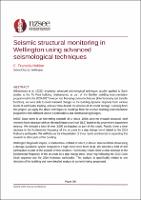Seismic structural monitoring in Wellington using advanced seismological techniques
Abstract
Sklodowska et al. (2021) employed advanced seismological techniques usually applied to Earth studies to the Te Puni building (instrumented as part of the GeoNet building instrumentation programme) for the 2009-2017 time-period. Focusing on two techniques (Interferometry and transfer function), we were able to track transient changes in the building dynamic response from various levels of earthquake loading, and over time despite the absence of structural damage. Learning from this project, we apply the above techniques to buildings from the GeoNet building instrumentation programme with different service functionalities and construction typologies.MBIE Stout street is an interesting example of a robust 1920s concrete encased structural steel moment frame structure with an elevated importance level (IL3) based on its government department tenancy. We selected a total of over 3,000 earthquakes as part of this study. Results show a clear decrease in the fundamental frequency of the structure in a step change trend related to the 2016 Kaikoura earthquake. We will discuss the interpretation of these results and interest in expanding this research to other parts of the building. Wellington Regional Hospital, a modern base-isolated structure, is also an ideal candidate showcasing a damage avoidance system designed to a high importance level (IL4). We selected a total of 903 earthquakes as part of the analysis of this structure. Preliminary results show a clear decrease in the fundamental frequency of the structure in a step change trend, occurring following the 2013 Cook Strait sequence and the 2016 Kaikoura earthquake. This analysis is specifically related to one direction of the building and more detailed analysis is currently being progressed.

